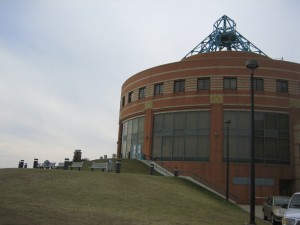On Monday, I returned to Kingsborough to celebrate the achievements of colleagues. Having just sold my car, the trip was like the trip taken every day by our  students: walk to the subway, transfer from the No. 2 to the Q, wait for the bus, and then walk from there to the college. The first time I did this was in December of 1996. The station at Atlantic Avenue was different then. Now it’s all shiny and new. In 1996, it was shabby and scary. But I had just read William Julius Wilson and wanted an inner city college teaching job.
students: walk to the subway, transfer from the No. 2 to the Q, wait for the bus, and then walk from there to the college. The first time I did this was in December of 1996. The station at Atlantic Avenue was different then. Now it’s all shiny and new. In 1996, it was shabby and scary. But I had just read William Julius Wilson and wanted an inner city college teaching job.
My 1996 travel adventure by subway to KCC was for a job interview with Bill Burger, the department Chair. (I had just moved to Manhattan from a bird sanctuary on Long Island). I couldn’t find the Q at Atlantic Avenue and so left the station to walk around outside, knowing from the map that the Q was somewhere close by. It was freezing outside (I eventually went to Macy’s and bought one of the big puffy down coats and even that wasn’t enough during the cold winter trips to KCC — after I got the job). On that first trip, even though I had allowed for two hours of travel time from the Upper West Side, by the time I finally found the street entrance to the Q, hopped on, and landed in Brighton Beach at the end of the line – over a mile from campus – it was already time for my appointment. This was before cell phones, and so I frantically went in search of a pay phone to call the department. The administrative assistant on the other end of the line was surprisingly relaxed, as was the Chair, when I finally arrived. I was stunned. In the world from which I came, arriving twenty minutes late for a job interview was the kiss of death. Bill smiled, shook my hand, and said that many people make that mistake, get off at Atlantic Avenue, turn around, and never come back – without even a phone call as to why. That was 18 years and one century of mind space ago.
 On my way home on Monday, I decided to take the new free bus service offered by the college. It’s an old school bus, one that has seen better days. The seats are worn, patched with engineering tape. I was reminded of sixth grade – my last year as a Safety Patrol officer – trying to persuade my classmates not to stick chewing gum under the seats. To take the bus is to re-enter the world of students – our KCC students – something I always try to do as a teacher.
On my way home on Monday, I decided to take the new free bus service offered by the college. It’s an old school bus, one that has seen better days. The seats are worn, patched with engineering tape. I was reminded of sixth grade – my last year as a Safety Patrol officer – trying to persuade my classmates not to stick chewing gum under the seats. To take the bus is to re-enter the world of students – our KCC students – something I always try to do as a teacher.
On Monday, the bus was nearly full when I hopped on, and so I grabbed an empty seat in the next to the last row, occupying the entire seat rather than making room next to me for a fellow passenger. It was 3:15 PM. Within the next five minutes, a young woman with longish blond hair sat across the aisle in the very last row – iPod and earphones intact. At around 3:20, I asked her if the bus had a schedule. She laughed and said she didn’t know but she didn’t think so. A couple more people hopped on board, and the driver geared up. My hypothesis was that either the bus left every half hour or that it left when the bus was full. Since we left at about 3:26, with a full bus, the evidence is inconclusive. But the young woman on the bus got off with me at Brighton Beach; she was nice and told me she liked my hair color.
The description of the bus sounds totally unremarkable in the absence of consideration for all of the things that can go wrong en route to class at KCC, even with the best of intentions: weather, train delays, bus delays, a shooting in the neighborhood, the death of a friend or relative, no day care, sick children, or not enough money left in the budget to pay the subway fare. During my many years of teaching at the college, I was less amazed by how often students were late to class, than by the fact that they managed to get there at all. The sheer determination required speaks volumes for the character of our KCC graduates.
Most of the students on the bus had iPods and earplugs. I think our students use these to tune out the world, but this topic merits close-up ethnographic study, perhaps replicating or expanding on the work of Sudhir Venkatesh. The iPod is the world of mass one-to-many communication — the deadening of interaction and engagement. Some students have interactive games that they play on these devices. I confiscated a live cell phone once in one of my classes — the owner had a category called “cute girls,” which kept lighting up throughout the class hour. But Monday on the bus, I did not get the sense that anyone was listening to downloaded podcast lectures from their classes or interacting with quiz materials or building digital maps or waiting for calls from “cute girls.” Most striking: there was no conversation – no comparing notes or exchanging ideas about classes or algebra problems or proms or new dresses or the Giants or civic issues. Just the silence of students in silos returning home. That they were there speaks to a desire to learn and engage. That they are wearing earplugs speaks to the challenge of engagement.
interacting with quiz materials or building digital maps or waiting for calls from “cute girls.” Most striking: there was no conversation – no comparing notes or exchanging ideas about classes or algebra problems or proms or new dresses or the Giants or civic issues. Just the silence of students in silos returning home. That they were there speaks to a desire to learn and engage. That they are wearing earplugs speaks to the challenge of engagement.
In my next blog, I suggest some ideas for integrating and ramping up strategies that we know work, drawing together what we have learned about digital technology, online and hybrid delivery, ASAP, eportfolios, learning communities, and MDRC research methodology. The goal is to develop a pedagogical delivery strategy that engages students at all levels in research – a strategy designed to extend a helping hand to community college students who want to learn but for whom the digital revolution to date means listening to music on an iPod. The strategy also promises to engage capstone and graduate students interested in human rights, following along the path set by Jessie Daniels with Just Publics and Cathy Davidson’s Futures Initiative. It is but one of many, many good ideas for effective pedagogy. And, I’m looking for partners.


